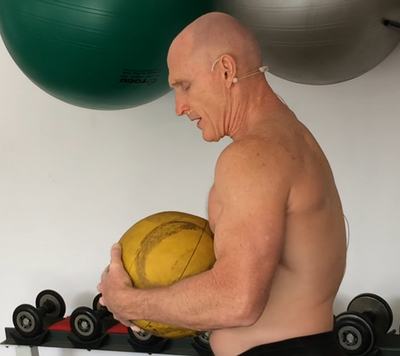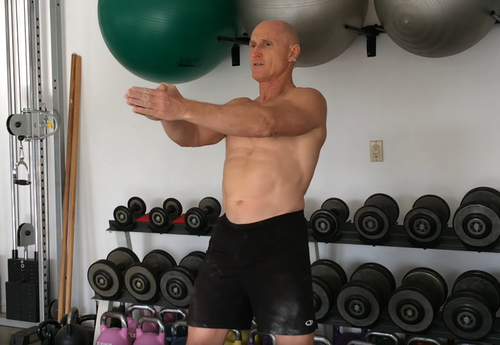The Washing Machine Exercise
 Welcome to a new week everyone!
Welcome to a new week everyone!
This time, I want to share the washing machine, an exercise I’ve used for a very looooong time. (Honestly, it’s so long ago that I don’t know if I learned or developed it!)
I gave this exercise its name because the key movement is very similar to the function of an agitator in a washing machine that twists and turns clothes during a washing cycle.
This exercise is designed so that you can develop, not only explosive rotational strength but deceleration too. The movements involved are concentric (turning the body) and eccentric (controlling the body’s rotation to change directions).
In my vlog, I show you how this works very powerfully with the one-two combination, the most powerful punching combination in the boxing ring.
There’s a myriad of applications for this exercise besides boxing, like kayaking, martial arts and sports that involve throwing balls.
To perform this exercise without hurting yourself, you have to be conscious about your posture and spinal mobility. If you aren’t careful, it can really tear you up, so don’t be a superhero!
One of my favorite strength coaches in the world and a man I worked with when he was on staff of the world champion Chicago Bulls teams, Al Vermeil, often reminded me, “Train slow, be slow.”
Here’s why you need to keep that in mind: The weight you use to perform the washing machine will affect your speed, so heavy ones probably aren’t the best idea. For you to get the benefit of this exercise, you’ll need to be moving at the speed required by the sport or environment for which you’ll be training.
The Importance of Good Posture and Structural Balance
Another tip: Be careful not to overtrain your abdominals. People who do are usually unaware that they have an outer unit dominance, which means the rectus abdominis and external obliques are overpowering the transverse abdominis and the ,posterior fibers of the internal obliques, which make up the inner unit system.
In people with outer unit dominance, as they rotate, their head and spine drops down into a slouched, poor postural position, which locks up the spine. This forces too much rotational force into the low back which reduces your ability to move. You really need your spine to rotate properly to perform this exercise correctly and without pain.

Not convinced? Try this exercise with no weights, as I often demonstrate to my students, to see just how far you can turn. With good upright posture and no outer unit dominance issues, you can rotate far better and farther and safely compared to when you do it and slouch at the same time.
If you slouch, you’ll probably get locked up pretty fast, so to rotate any further you’d have to move into the lumbar spine which doesn’t like rotation, not to mention the facet joints are fairly vertical to protect the discs too. That can really start irritating your sacroiliac and hip joints and neck and you’ll soon feel contraction patterns in your adductor muscles too.
Also, if you’re going to perform explosive movements, you’ll need a solid base of support so be sure to maintain soft knees with your legs a little distance apart. Otherwise, you’ll be flopping around like a fish.
Breathing and Tempo
Pay attention to your breathing during this exercise, and adjust it as necessary. When you start moving really explosively, it’s very, very hard to breathe in and your diaphragm will tighten up as a means of stabilizing your spine.
You’ll find you need to take a big breath in at the start of the exercise and lock it in. Then, you’ll have to somehow find a way to breathe dynamically (probably through the middle where the torque is reduced, especially if you’re doing long sets).
Reps and Sets
The length of the sets will be determined by what you what to accomplish. If you’re going to be kayaking or doing a 1,000-meter race, you’ll need lots of reps. You may want to do shorter sets of 8-12 seconds if you’re developing explosive power for boxing and martial arts.
However, if you’re trying to develop endurance for boxing, you might mix that up with longer sets where you go maybe as high as three minutes. Just stay a bit on the conservative side though or you’ll injure yourself.
I highly recommend, if you’re doing any kind of martial arts or boxing training, that you don’t do those exercises before any kind of sparring or technique work. Why? This exercise will leave you fatigued, and your form, speed and reflexes will drop down.
Finish your high skill work first, or do that on separate days. The alternative: You’ll be a fit person who gets beat up a lot and sustains a lot of injuries.
For my vlog, I demonstrate how to perform the washing machine using a nice, dirty and old 16-pound medicine ball that’s traveled with me for the past 25 years.
If you want to learn more of these types of exercises, check out my Dynamic Medicine Ball Training videos and course. I produced these a long time ago, but the exercises, concepts and physiology is still as valid today as it was back when I was a young man!
For more on functional anatomy, key assessments and also some high performance exercises, I recommend Scientific Core Conditioning course, which is very comprehensive and covers a great deal about effective assessments and training of the core.
See you next week!
Love and chi,
Paul














Find me on the web